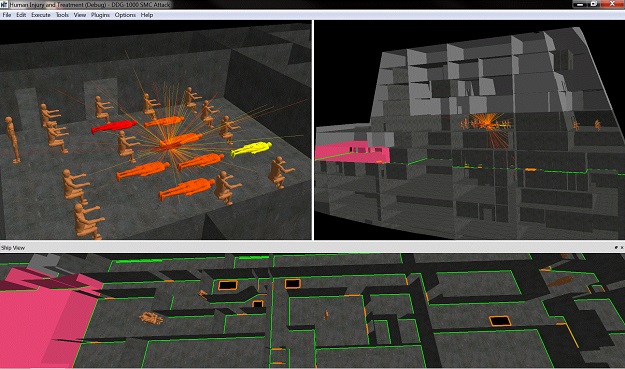HIT: Human Injury Treatment modeling tool
Challenge
Human Injury Treatment (HIT) is a computer modeling tool for predicting human injury, incapacitation, medical response requirements, and patient outcome associated with weapon engagements in shipboard environments. The HIT program was initially requested by the Office of Naval Research, looking to assist Live Fire Test and Evaluation (LFT&E) groups seeking to address knowledge gaps associated with crew casualties resulting from weapons damage. The scope of HIT has since been expanded to support the medical logistic and manpower communities as a decision support tool.
Solution
HIT is composed of three major modules:
- Injuries. At the start of a simulation, human injury models are combined with personnel location data and environmental conditions to predict incidence, type, and severity of injuries. Based on the predicted injury state, Military Combat Injury Scores (MCIS) are assigned to each crew member informing the Medical Treatment Module (MTM) to the number and severity of injuries received.
- Medical Response. The MTM contains sophisticated queuing algorithms for simulating the progression of patients through medical treatment facilities, predicting outcomes, and estimating resource utilization. The MTM is based on the Joint Medical Planning Tool model developed by the Naval Health Research Center.
- Manning. Operating alongside the medical response and the human injury simulators, the ship manning module tracks personnel locations, duty assignments, and movement (including obstacle avoidance). The module provides updated information on personnel incapacitation to the ship manning module to determine the mobility status of crew members, identify crew members killed or lost to the mission, and determine when less severely injured crew members may return to duty.
Together, these modules provide the backbone of a 3D simulation of interactive or batch runs that generate diagrams describing the distribution of injuries, treatment outcomes, injury severities, and operational impact. For use in recoverability modeling, HIT can output the availability of personnel with specific capabilities or responsibilities as a function of time.
HIT is capable of measuring, tracking, and determining the extent of human injury, treatment options, ability to return personnel to duty, and document onboard personnel outcome assessments (including fatality reporting) with great accuracy. HIT is also capable of assessing the most taxing injury and treatment conditions—such as weapon hits—and provide probabilistic roll-up results for a large number of realistic hit points and resulting injury scenarios. This modeling capability takes into account shipboard medical allowance designation (supplies), available medical personnel, personnel training levels, ship operating conditions (normal sailing or battle engagement), injury progression (degradation of injuries prior to treatment), and confounders (other conditions that would modify the treatment given).


